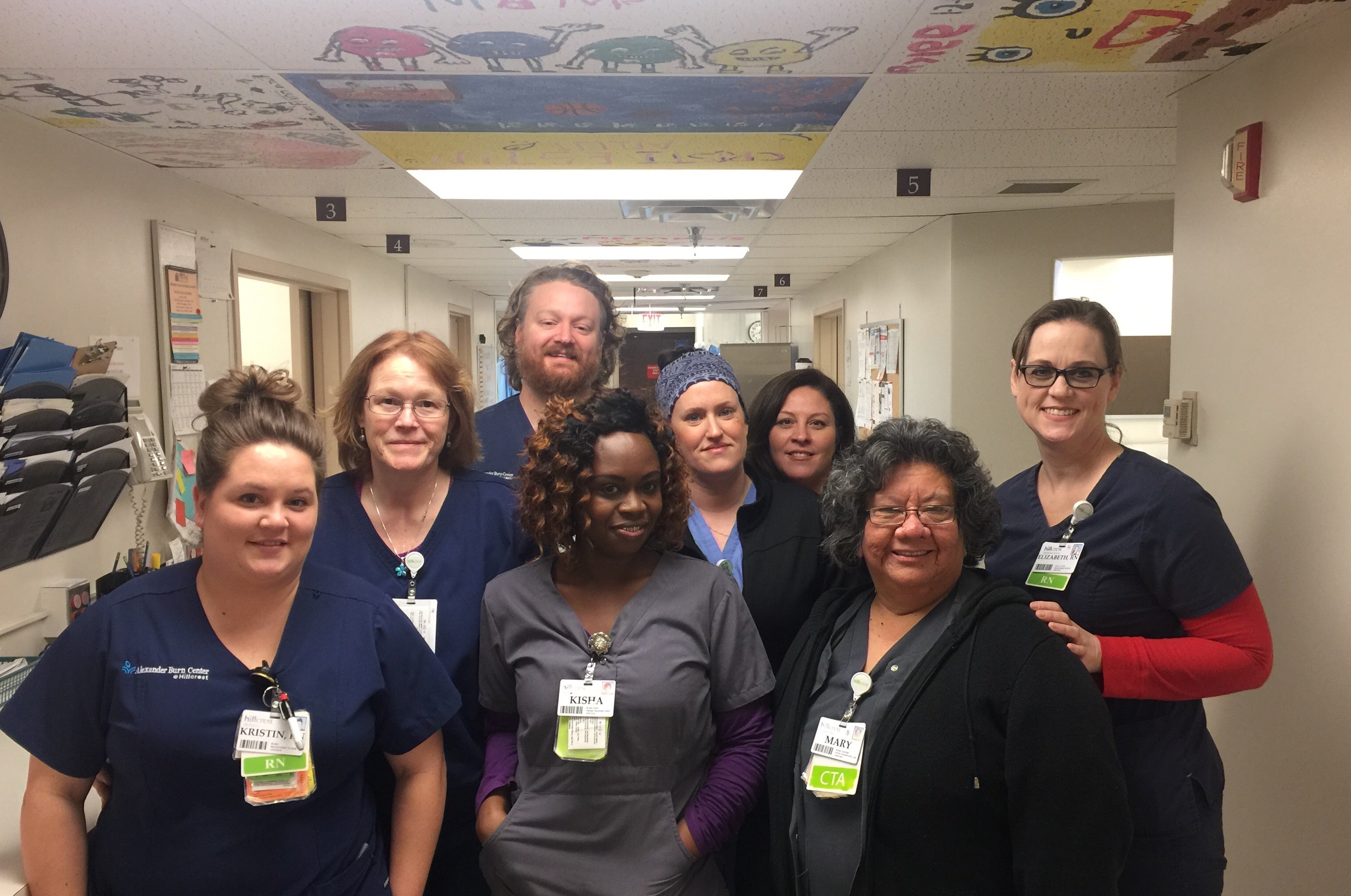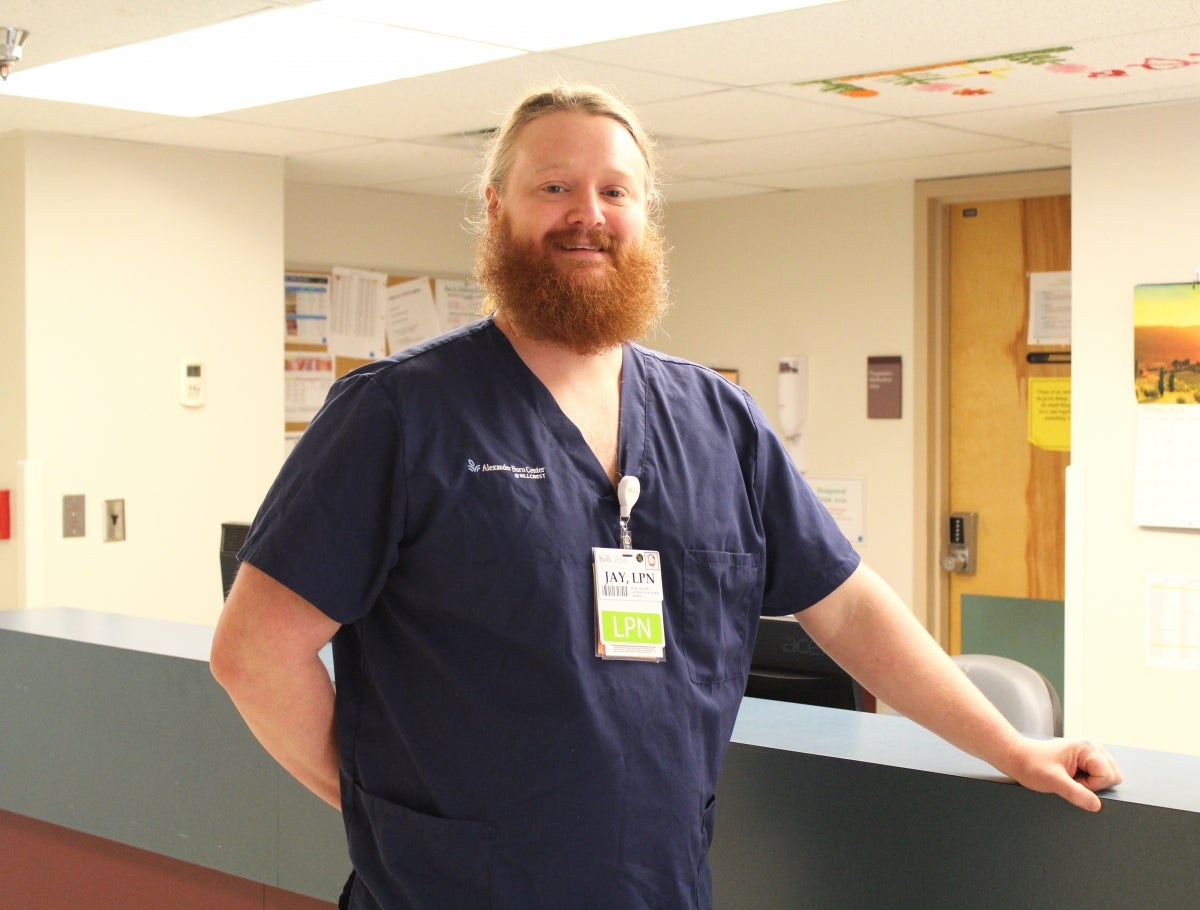
Behind the doors of the Alexander Burn Center located within Hillcrest Medical Center, a dedicated and specialized group of doctors, nurses, therapists and staff witness patients making remarkable progress in some of the minutest measurements. The instantaneous moment that changed patients’ lives forever meets the place and the people who work tirelessly to heal and restore burn survivors. The care and commitment required to move the mountains on a patient’s journey home creates a community bond unlike any other place in the hospital. It is one that extends well beyond the weeks or months of inpatient care and only grows stronger with time.
 “It is a very long process for some patients,” shares Jay Gray, LPN, who started working in the burn center in 2008, first as a certified nurse assistant. “It is a hard job, but it is very rewarding and has become my passion.”
“It is a very long process for some patients,” shares Jay Gray, LPN, who started working in the burn center in 2008, first as a certified nurse assistant. “It is a hard job, but it is very rewarding and has become my passion.”
“I’ve always been drawn to burn,” adds physical therapist Jennifer Knowlton, PT, who has been on the burn team since 1992. “I always tell people when you get to see someone go from being critically ill and possibly not surviving an injury to getting better and walking out that door, returning to their family and life, that’s what keeps me here in the burn center.”
Jay and Jennifer are two on a team of many who painstakingly work with patients to treat devastating and debilitating burn injuries. From the moment a burn patient is admitted to the intensive care unit (ICU), they are under the care of a team. “That is one of keys to our success with our patients,” Jennifer explains. “From our physicians to our nurses, therapists and housekeepers, everyone is part of the team.”
“Getting patients mentally and physically prepared to go back for dressing changes is a lot of work and could be overwhelming for one person,” adds Jay. “This is a big team effort.”
Burn care is more than treating the injury. Burns rob patients of their mobility, covering their bodies in a blanket of extreme pain. “My patients are in such tremendous pain and then I’m asking them to get out of bed and walk,” shares  Jennifer of working with patients on gaining back movement – the first steps towards freedom. “You have to have compassion and patience if you expect someone to get up and work through something so painful. It is worse than any pain they have ever experienced, but it is not just physical, it is emotional and psychological. We have to work through all of that.”
Jennifer of working with patients on gaining back movement – the first steps towards freedom. “You have to have compassion and patience if you expect someone to get up and work through something so painful. It is worse than any pain they have ever experienced, but it is not just physical, it is emotional and psychological. We have to work through all of that.”
Together patients and Burn Center staff tackle obstacles and meet milestones. A relationship built on trust grows stronger than the pain. “It is a really hard process our patients go through with the initial burn and the healing,” adds Jay. “Many of our patients have surgery. They definitely have to have a shoulder to cry on sometimes. It is more than physical obstacles. There is mental anguish involved.”
At shift change, the burn center staff go home, but they never leave their patients. “When I’m leaving I check with my patients to make sure they’ll be alright,” Jay shares. “You get attached to your patients. Sometimes when I get back on Monday after a weekend off, they aren’t here – they’ve been discharged home.”
And that day – the day a patient goes home – is a celebration unlike any other event in the lives of patients or staff. “When they are ready to go home, many times they are walking out the door,” Jay says. “It is special to see them overcome everything they have gone through and go home and get back to their lives.”
As patients are getting back to life after surviving their injuries, many return for outpatient visits – physical or occupational therapy, garment fittings or dressing changes. It is not uncommon, however, for patients to return just to see the familiar faces who helped them during one of the most difficult times in their lives. “Our burn patients come back frequently to say thank you to those who took care of them,” shares Jennifer.
Gena Waldeck, LPN, was first introduced to the Alexander Burn Center community at a distance; listening to a physician she worked with share stories of the Oklahoma Firefighter’s Burn Camp, where many burn center staff, including Jennifer, who serves as the camp’s director, volunteer every August. “I asked him ‘How do I get involved?’” she recalls of her interest in volunteering as a nurse at the camp. “I didn’t know what to expect, but within the first two days, I knew it was a great thing.”
Burn camp is not only a place where campers feel unconditionally welcomed and accepted despite their injuries, but an opportunity for survivors and staff to stay connected. “One patient I took care of was 18 months old when she was burned,” Jennifer shares . “She not only survived, she went on to play sports. She was a straight-A student. Now she is in college. I really can’t even put it into words what it means when I get to see her at camp each year. I remember when she came in the burn center and she was critically ill. Now she’s going to be something amazing!”
Joining Jennifer and other burn center staff, firefighters, health care professionals and teachers who volunteer at camp, Gena is surrounded by burn survivors who arrive as campers, counselors and volunteers as well. “It feels like family,” she adds. “It’s our burn camp family. We are all brothers and sisters. Everyone gets involved to make everyone comfortable and at home.” Like many, burn camp has become a tradition for Gena, who has volunteered six years in a row. “My family knows those five days in August that I’ll be at burn camp.”
When the unimaginable happens, those who are called to burn care at the Alexander Burn Center, as well as those who volunteer at the Oklahoma Firefighter’s Burn Camp, rally to help each survivor have the best chance of overcoming a challenge they never wanted to meet. “It is truly a burn community,” Jennifer echoes of the bond between burn survivors and those who are vitally important on their journey to getting back and enjoying life again. “It is the most amazing and rewarding experience there is.”
